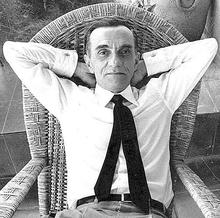João Cabral de Melo Neto facts for kids
Quick facts for kids
João Cabral de Melo Neto
|
|
|---|---|
 |
|
| Born | João Cabral de Melo Neto 6 January 1920 Recife, Brazil |
| Died | 9 October 1999 (aged 79) Rio de Janeiro, Brazil |
| Occupation | Writer |
| Notable awards | Camões Prize 1990 Neustadt International Prize for Literature 1992 |
João Cabral de Melo Neto (born January 6, 1920 – died October 9, 1999) was a famous Brazilian poet and diplomat. He was one of the most important writers in the later part of Brazilian modernism, a time when artists tried new ways of expressing themselves.
João Cabral won two very important awards: the Camões Prize in 1990 and the Neustadt International Prize for Literature in 1992. He is the only Brazilian poet to have won the Neustadt Prize. Many people thought he might even win the Nobel Prize in Literature because his work was so good.
His poems are known for being very careful and well-structured, almost like a building. He often used a traditional type of verse with five or seven syllables. He also used rhymes in clever ways. His style changed over time, from early poems that were a bit dream-like (called surrealist) to later ones that focused on his home region in northeastern Brazil. In many of his works, like the famous play Morte e Vida Severina, he wrote about the lives of people who faced poverty and unfairness in Pernambuco.
Contents
Life and important career moments
João Cabral de Melo Neto was born in Recife, a city in Pernambuco, Brazil. He spent most of his childhood on his family's sugar-cane farms. He was also a cousin to another famous poet, Manuel Bandeira, and a well-known sociologist, Gilberto Freyre. In 1940, his family moved to Rio de Janeiro.
In 1942, João Cabral published his first book of poems, called Pedra do Sono. He paid for it himself, and only 340 copies were printed. In 1945, he started working as a diplomat. A diplomat is someone who represents their country in other nations. He worked as a diplomat for most of his life. The next year, he married Stella Maria Barbosa de Oliveira, and they had five children.
He lived and worked in many different countries. In 1984, he became the Brazilian consul in Porto, Portugal. He returned to Rio de Janeiro three years later. He spent many years working in Spain, especially in the city of Seville. His experiences there greatly influenced his poetry.
In 1956, João Cabral published his most famous work, Morte e Vida Severina. In 1968, he was chosen to be a member of the Brazilian Academy of Letters, which is a very important group of writers and scholars.
In 1986, he married Marly de Oliveira. Two years later, he retired from his job as an ambassador. João Cabral de Melo Neto passed away in 1999 in Rio de Janeiro. During his career, which lasted over 50 years, he published 18 books of poetry and two plays.
His unique poetry style
João Cabral de Melo Neto once said: "Poetry is not the product of inspiration triggered by feeling, but the product of the poet's patient and lucid work."
Many people describe his poetry as being like an engineer designing a building. This is because his poems are very carefully planned and structured. From the very beginning, his poetry was full of strong images. When talking about his first book, Pedra do Sono, a critic named Antonio Candido noted how João Cabral used words almost like pictures.
However, he quickly started to pay close attention to the social problems in his home state. In O cão sem plumas (“A Dog without Feathers”), a long poem from 1950, he wrote about the lives of very poor people who depended on the Capibaribe River. He also described the hard work in the sugar-cane mills. Three years later, in O Rio (“The River”), he wrote from the river's point of view, telling the story of its journey and the villages it passed.
Another poet, Augusto de Campos, said that João Cabral's work was very new for Brazilian poetry. He said that João Cabral's poetry was not about feelings but was objective and focused on real things.
Main works
Poetry books
- 1942: Pedra do Sono (Slumber Stone)
- 1943: Os Três Mal-Amados (The Three Unloved)
- 1945: O Engenheiro (The Engineer)
- 1947: Psicologia da Composição com a Fábula de Anfion e Antiode (Psychology of Composition with the Fable of Amphion and Anti-Ode)
- 1950: O Cão sem Plumas (The Dog without Feathers)
- 1953: O Rio ou Relação da Viagem que Faz o Capibaribe de Sua Nascente à Cidade do Recife (The River or On the Course of the Capibaribe River from Its Source to the City of Recife)
- 1960: Dois Parlamentos (Two Parliaments)
- 1960: Quaderna
- 1966: A Educação pela Pedra (Education by the Stone)
- 1975: Museu de Tudo (Museum of Everything)
- 1980: A Escola das Facas (The School of the Knives)
- 1985: Agrestes
- 1987: Crime na Calle Relator (Crime in Relator Street)
- 1990: Primeiros Poemas (First Poems)
- 1990: Sevilha Andando (Walking around Seville)
Plays
- 1955: Morte e Vida Severina (translated in part by Elizabeth Bishop as Life and Death of a Severino)
- 1984: Auto do Frade (Auto of the Frair)
See also
 In Spanish: João Cabral de Melo Neto para niños
In Spanish: João Cabral de Melo Neto para niños

